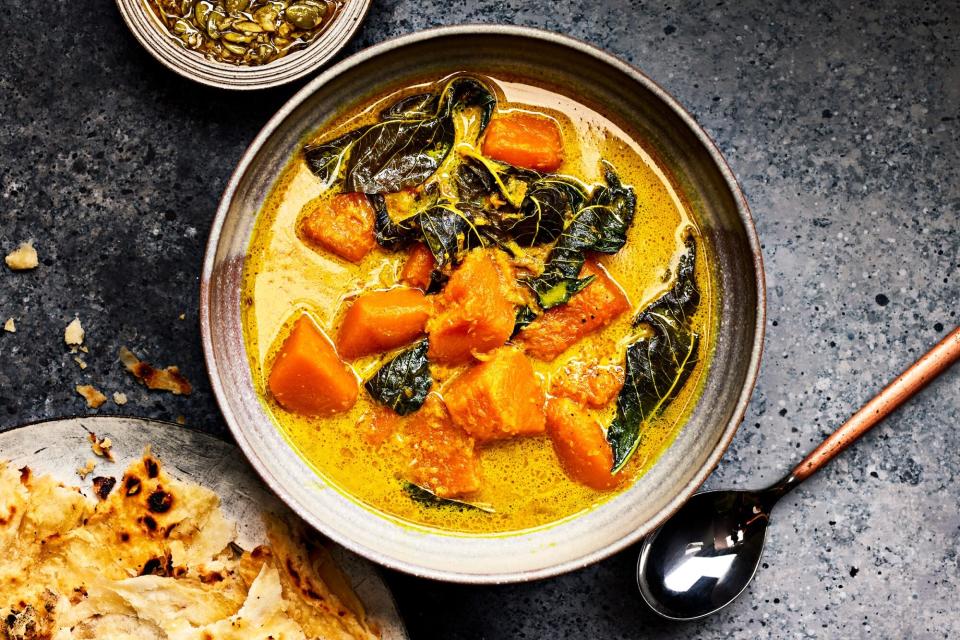The Real Story of Curry
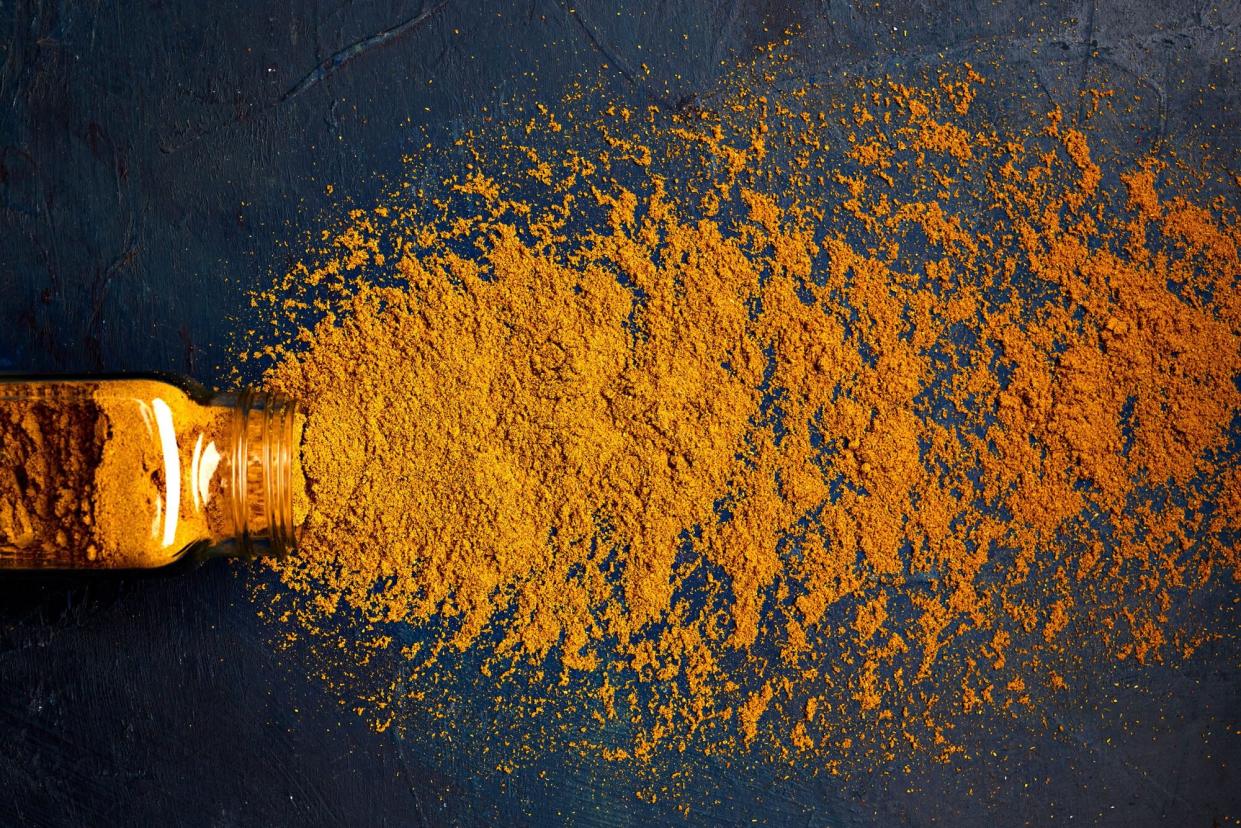
Victor Protasio / Food Styling by Chelsea Zimmer / Prop Styling by Claire Spollen
"I paid a lot of bribes to learn, to be honest with you," Chintan Pandya, chef and partner of several excellent Indian restaurants in New York City, tells me with a look of bemusement.
We're in the kitchen at Dhamaka, his restaurant of provincial cuisine dubbed "unapologetic Indian," which looks out on bustling Delancey Street in the Lower East Side. The chef drops a handful of curry leaves in a small aluminum pot containing hot coconut oil and just-popped mustard seeds. The curry leaves sizzle-dance and turn a shade of green that's nearly black. He sets the pot aside so we can talk about curries — perhaps the world's most simultaneously controversial and widely beloved foods.
"First and foremost, I think it's a British term. We use the word kari in different ways and forms. But the [Western] perception of curry is anything with a liquid curry gravy," says Pandya. "They will call it a 'butter chicken curry.' It's not; it's just butter chicken."
When he was in his mid-twenties, Pandya, who calls himself "an accidental Indian chef," threw himself into learning the country's vast regional cuisines after his hotel group Oberoi assigned him to an Indian kitchen. He would show up to the doorsteps of other Oberoi restaurants, sometimes traveling 18 hours by train to visit Kashmir, Rajasthan, Gujarat, and Kolkata, asking the chefs there to show him their home recipes — often with the bribe of a bottle of whiskey. It was around that time that Pandya started thinking about the nature of curry.
"Everything is so different everywhere. The more you keep on studying, the more you'll understand how diverse curry is. We eat food to understand culture. You don't know who you're going to connect with."
—Chintan Pandya, Dhamaka, New York City
"As a kid growing up, you hear the word 'curry,' but it was not a common term," he says. "I grew up in Mumbai in a vegetarian household — we never had anything called 'curry,'" says Pandya. "But my neighbors, who ate meat, would say 'OK, today we are making chicken curry.' And in Southern India, it's kari. There was nothing wrong with that."
That's the funny thing about curry: It's a slippery term. It could be one dish in one culture (like Japanese kare raisu) or an expansive category unto itself in another (like in Thailand). It can have curry leaves or not. It can be a gravy, or it can be dry. Most curries come from the Indian diaspora, except Thai and Malaysian curries, which have their own lineage. Curry seems to suffer from an existential instability — it's not so much a recipe as it is a physical phenomenon that must be perceived to exist.
Perhaps this is why London food writer Sejal Sukhadwala named her tome on the subject The Philosophy of Curry. Much of the confusion, of course, comes down to the fact that the word curry was used by an imperialist power, Britain, to describe an array of dishes made by many different communities in another culture. It's been a controversial term, too, weighted with the heft of a brutal and extractive colonial rule: One economist estimated that $45 trillion was stolen from the country under the British, and former Under Secretary-General of the U.N. Shashi Tharoor wrote that the "British colonial holocaust" took the lives of tens of millions of Indians by unnecessary famines.
"Turmeric was something that was brought over by our ancestors, So it's about respecting the people who were coming before us. And we kept that tradition going."
—Nina Compton, Compère Lapin, New Orleans
According to Sukhadwala, the word curry can be traced back to the Portuguese, who used caril in Goa in the 16th century. It may have been adapted from kari in the Malayalam, Kannada, or Tamil languages — the last of which can translate to "a spiced sauce." In Portuguese, the plural of caril was carie or curree, which the British further evolved into curry. After officers at the East India Company set up trading posts and villages in India in the 17th century, they took a liking to local dishes, but they didn't seem to grasp the country's culinary nuances, as Sukhadwala notes, and clumsily mashed together different techniques and cultural traditions. India is 1.27 million square miles (about 13 times the size of Britain), with variable climates, ancient influences (Arab traders, Jewish settlers, Mughals, Persians), and many religions (Hindu, Muslim, Jain, Buddhist), as well as castes and other subsects. In a fog of imperial arrogance and ignorance, the British compressed this vast diversity into a singular curry. They further recontextualized it to a ranking of spiciness: It was in a gentleman's club in Kolkata, the Bengal Club, where curries sold to golfers were denoted as mild, medium, and hot — a practice that spread to Britain as well as other Western countries to label dislocated cuisines, like that of Thailand.
The British also didn't seem to understand spices: At least two early British food writers claimed that curry powders were more reliable than making your own spice mixtures; one of them also asserted that spices improved with age. Commercial curry powder — a blend often including coriander, turmeric, fenugreek, black pepper, cumin, and ginger — flowed out through the empire. Before the American Revolution, curry powder was among the luxury goods that well-off colonists could order. (A 1771 listing in the South-Carolina and American General Gazette listed it among a "compleat assortment of European and East-India GOODS.") Of course, there were spice mixtures in India, of a countless variety, but the idea that every stewed spiced dish would be well-suited to one flavor profile was a uniquely British innovation.
"Thai curry is the reflection of our culture. The way of living in each region translates into each curry. The curry that I make celebrates the southern part of Thailand. We serve it on special occasions for prosperity because it's gold."
—Nok Suntaranon, Kalaya, Philadelphia
"Britain was the [creator of] curry powder," says Pandya of India's historical dissociation with the product. "We never used that. So it was very funny."
In Britain, restaurants featuring curries also proved to have currency — many serving as a financial springboard for entrepreneurial immigrants. Not all were successful. London's first Indian restaurant, Hindoostane Coffee House (1810), closed after a year. But other immigrant-owned restaurants, like Kohinoor and Shafi's, both of which opened in the 1920s and catered to Indian students, were hugely popular. A few decades later, former Bangladeshi sailors, many of whom worked at restaurants such as Veeraswamy's (London's longest-running Indian restaurant), took over bombed-out fish-and-chips shops after World War II. They served the same menu to the clientele of working-class white men but added curry and stayed open late for drinkers stumbling back from the pub. The restaurant owners, according to Sukhadwala, didn't have time for the demands of traditional Indian cooking (long simmering, grinding spices, staggered cooking stages), so they made fast-food-like innovations, like adding boiled onion paste as a thickener. Eventually, customers started ordering curry as a condiment for chips, and as curries grew more popular, British dishes disappeared from those shops' menus.
Curries also made their way around the world, largely through indentured workers after the British Empire abolished slavery in its colonies in 1833, as Lizzie Collingham recounts in Curry: A Tale of Cooks and Conquerors. Starting in 1838, Indian laborers, who signed work contracts in hopes of escaping poverty, were sent to Demerara, Mauritius, Trinidad, Guyana, Jamaica, Malaysia, Sri Lanka, parts of Africa, and Fiji.
"Curries are all around the Caribbean through the slave trade — lots of indentured servants came through sugarcane," says St. Lucia–born chef Nina Compton. "Unfortunately, some of the most memorable and soul-satisfying food was a necessity. Food is about survival and comfort and bringing people together." When Compton was growing up, curries were a staple lunch with roti. She remembers picking bay leaves from her family's backyard tree to make them.
When the British took over South Africa, they brought indentured laborers from mostly South India to work on the sugar and tea plantations. During apartheid, Black South Africans were banned from non-Black restaurants, so Indian shop owners turned curry into contraband — a sort of minor spiced resistance, disguised inside hollowed-out bread rolls and sold covertly out of back doors. But the spread of curry via colonization was not limited to the British. The Portuguese, according to Colleen Taylor Sen in Curry: A Global History, also brought Goans to colonies in modern Angola, Madagascar, Mozambique, Zanzibar, and Equatorial Guinea.
"Japanese curries come in infinite varieties, but one of the most popular is tonkatsu curry. What must always accompany Japanese curry is pickles, and with tonkatsu, shredded cabbage. Since this is an everything-on-it Japanese curry, you get both."
—Sonoko Sakai, author of Japanese Home Cooking, Los ANgeles
Curry is beloved in West Africa, too, where it may have made its way from the formerly Portuguese Guinea or British Gambia. Pierre Thiam, owner of food brand Yolélé and West African casual chain Teranga in Manhattan, grew up in Senegal eating lamb and chicken curries, made with potatoes, carrots, and cabbage, served over rice. It was a dish his mother brought out with pride when guests came over for dinner. There were various spiced stews in West Africa, but curry was defined by a specific spice profile: turmeric, cumin, coriander. Thiam didn't know that curry wasn't a uniquely Sengalese food until he left. "That was my world of curry," he says. "I traveled to New York and started to see Thai, Indian, all these curries." The universe of curries, as it were, is ever expanding.
Curry fever took off most fantastically in Japan. "Japanese curry has been designated the national dish of Japan — that's how seriously people take it," says Sonoko Sakai, author of Japanese Home Cooking. "People in Japan eat curry about one and a half times a week." During the Meiji Restoration (1868-1889), a previously isolated Japan opened up to the world, and Portuguese traders, Anglo-Indian officers, and missionaries brought curry with them. The Japanese curry is typically a meat (usually chicken or beef) simmered with carrots, onions, potatoes, and a curry roux or powder; sometimes topped with tonkatsu; often accompanied by pickled vegetables; and served with either rice or udon.
At first, it was, as Sakai puts it, "a very sophisticated upper-class food." Soon, the military and schools both added curry, easy to batch and serve in large quantities, to their menus. Ready-made Japanese curry roux — curry powder thickened with butter and flour — launched in the mid-20th century, including the popular Vermont Curry (sweetened with apple and honey), most iconically in the curry "brick" form. The industrialization of curry disguised its makeup. "I just thought curry was a tree," says Sakai. These days, she makes her own spice blend using fresh spices.
If there is a through line in the many stories of curry, it is the spices. After all, it was the global pursuit of spices that set up the conceptual evolution of curry. Until the 15th century, Arab traders controlled spice routes and charged exorbitant prices, with the British, Portuguese, Dutch, and French racing to establish their own direct connections.
"[Curry] just takes me back home, bringing me to those memory places. It was very important to me at a time when I was young and lost, and missing home—it took me there through food."
—Pierre Thiam, Teranga, New York City
"Turmeric was something that was brought over by our ancestors," says Compton. "And we kept that tradition going. Turmeric is grown locally, bay leaf, cinnamon — all those things, we grow in the islands. Star anise, coriander, cumin, Scotch bonnet, green cardamom. You can't have a curry without cardamom."
Curry, with all its bloody colonialist history, speaks to this survivalist spirit of humans: the enterprising Bangladeshis making their way in a strange new country over pots of "hot" and "mild" curries; the great-grandchildren of indentured laborers in the Caribbean picking bay leaves from their gardens; the Indian restaurateurs secretly passing bread-shrouded curries to Black South Africans under apartheid. If anything, curry is an emblem of the insuppressible creativity of the oppressed who seize on the impossibly minute opportunities to subvert the tools of their oppressors, eventually so they may break free.
In Britain, while the number of curry houses on London's Brick Lane has fallen to a third of its peak, the country now has eight Michelin-starred Indian restaurants, and home cooks make their own spice blends for Indian dishes with gravy looking to Indian-British cookbook authors for their recipes. When Chintan Pandya started out as a chef, Indian cuisine in India wasn't as prestigious as Western cooking. He decided to become a master Indian chef nonetheless. "I think opportunities always lie in that void," he says of his choice to eschew the then-more-prestigious career path of European food.
Almost a mile from New York City's own curry row, Dhamaka — one of America's most celebrated restaurants — now sits. The word curry does not appear anywhere on its menu. But one might argue that the world's now-archaic curry routes made the way for it. Still, Pandya notes with a laugh and a shrug, back in India, curry has been adopted as a convenient categorizing device on many menus. And perhaps there's nothing wrong with that.
Aloo Matar (Indian Potato and Green Pea Curry)
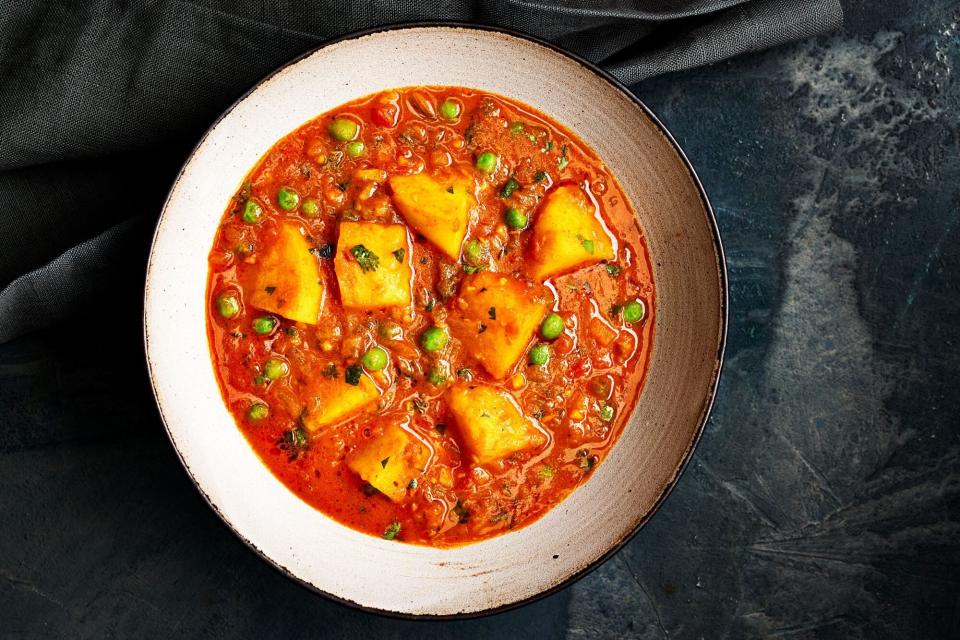
Lamb, Sweet Potato, and Coconut Mafé Curry
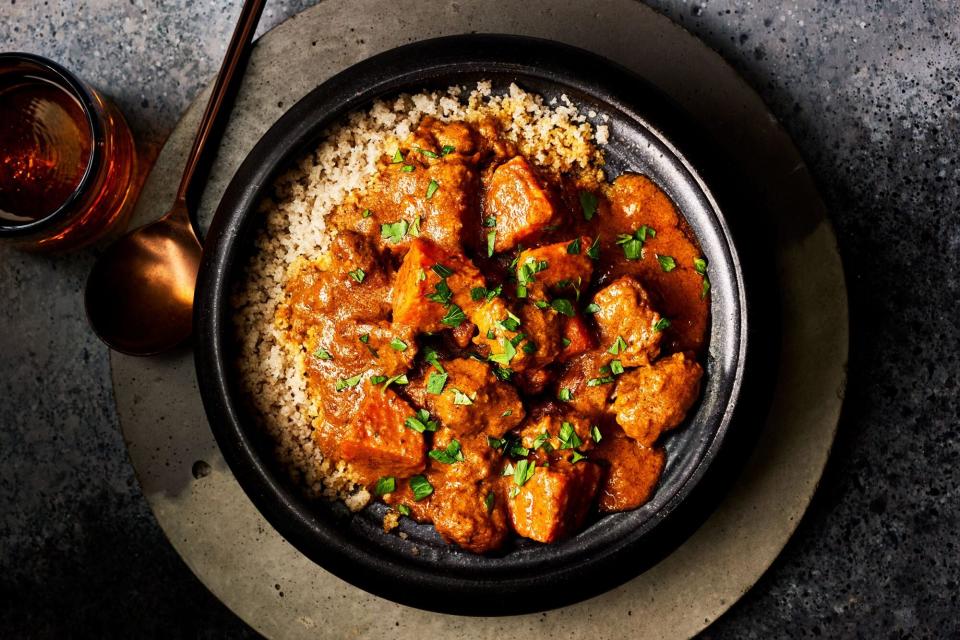
Katsu Curry (Japanese Curry with Tonkatsu Nuggets and Fried Egg)
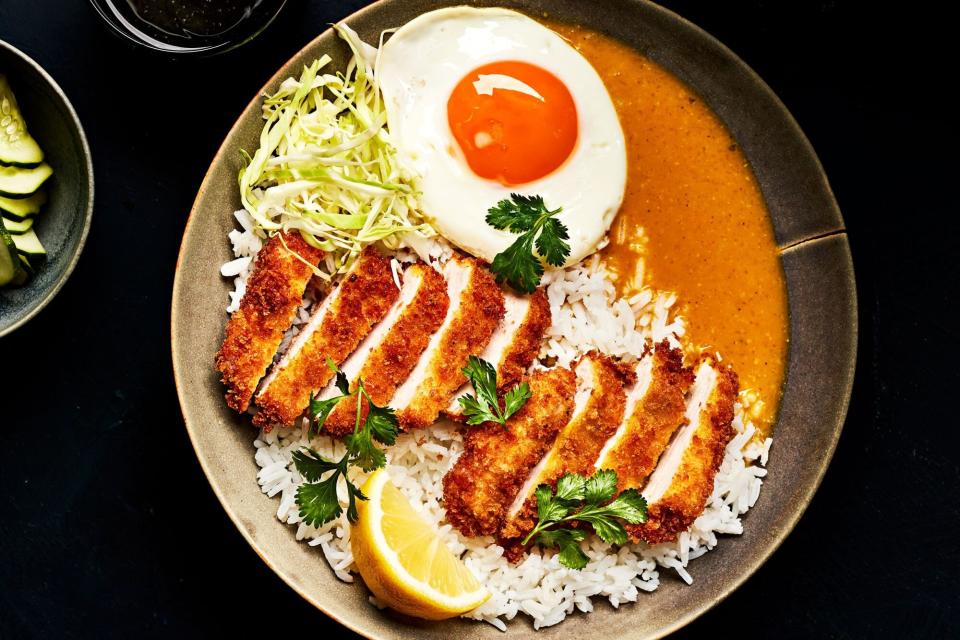
Gang Gai Khao Mun (Thai Chicken Curry)
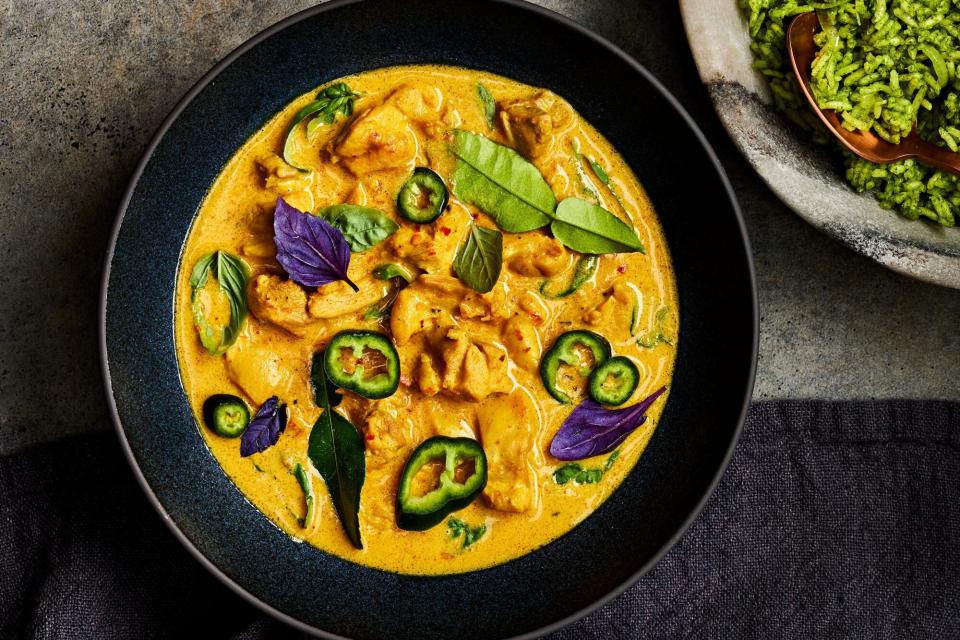
Curried Pumpkin and Buss Up Shut (Paratha Roti)
